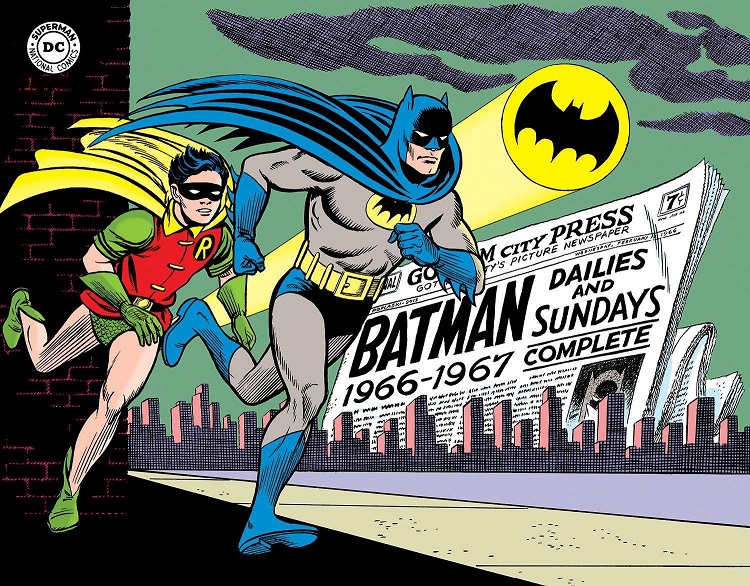
IDW’s Library of American Comics and DC Entertainment have teamed up to release Batman’s Silver Age newspaper strips, which debuted a few months after the classic television show hit the airwaves, so naturally the tone is light and humorous, as opposed to the serious and somber “Dark Knight” iteration that has been so popular since the mid-’80s.
This was the Caped Crusader’s third comic strip and the longest, running from 1966 until ’74. Volume One covers the years 1966 and ’67. Although Bob Kane’s name appears in every strip, the book does a great job of crediting the creators, who didn’t get that same consideration in the newspapers. The stories in this book were all written by Whitney Ellsworth. The strip began with art by Shelly Moldoff, saw Joe Giella do the majority of the drawing during this time period, and included a brief stint by Carmen Infantino. Even the letterers get acknowledgement of their work.
Initially, the Sunday and daily strips told separate stories. Beginning mid-December 1966, they blended together. Batman and Robin, with some assistance from butler Alfred and eventually Batgirl, take on familiar faces from their rogues gallery: Catwoman, the Penguin, the Joker, the Riddler, and Poison Ivy. Also up to no good are Little Napoleon, Blue Max Baron, Madame Zodiac (whose storyline continued into ’68), and different versions from their comic-book namesakes of Jolly Roger and the Collector. Two real-world figures appear in Gotham. Conrad Hilton wants to build a Batman-themed hotel, and Jack Benny hires the heroes to retrieve an expensive violin.
The characters are a bit silly. Batman is a ridiculous do-gooder and Robin is quite a brat. While racing to stop some crooks, Batman makes Robin change an old lay’s flat tire. Other times, he pulls over to help a cub scout across the street or sign an autograph for a young boy. Robin is excitable and quick to anger. He rudely gives Superman the brush off during the Kryptonian’s brief cameo but Batman makes him apologize. He also is easily agitated by girls, as a young man can be.
The stories are light-hearted and the results never in doubt, but a serious turn is taken after Batman gets amnesia and Robin has to tell him how their parents died. Yet, I had to laugh after Robin knocked out the amnesia-suffering Batman soon after learning he had received a concussion in the Batcopter crash. The most ridiculous situation may have been during their search for Batgirl. Bruce and Dick dress up and go out as bank robbers. Dick is wearing a mask no different than Robin’s. They get arrested and Commissioner Gordon recognizes him as Dick with the mask on, yet no connection is ever made by him.
Unfortunately, there is some racially insensitive material. The two Asian characters are a fortune-cookie baker named Fat Lip and Batgirl’s assistant, Ho Say Guy, who only wears a judo outfit. They are tame in comparison to a Native American woman Joker works with named Laughing Girl. She speaks broken English and makes frequent use of “how,” “heap,” and “ugh,” and even inexplicably calls Batman, “yellow-hair.” What’s worse is learning more about the character at the story’s conclusion.
Better than the writing is the artwork. The panels feature great use of inks and shadow. The combination of figure drawing and the use of lines and words do a marvelous job of creating a sense of action and movement. The Sunday strips are enhanced by the bright colors used.
Batman: The Silver Age Newspaper Comics, Volume One: 1966-1967 is a welcome addition to any Batfan’s library and is a great showcase of Joe Giella’s work.